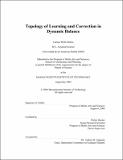Topology of learning and correction in dynamic balance
Author(s)
Welti-Santos, Larissa, 1978-
DownloadFull printable version (1.306Mb)
Other Contributors
Massachusetts Institute of Technology. Dept. of Architecture. Program in Media Arts and Sciences.
Advisor
Walter Bender.
Terms of use
Metadata
Show full item recordAbstract
"The discrepancy between [our personal experiences] and our idealizations of knowledge leads us into counterproductive strategies for learning and thinking" (Papert 1993). This discrepancy has driven most research towards understanding how people fail to accomplish a task, while few researchers have focused on looking at those instances where people have developed strategies for correcting their failure. This work has as its core belief that by identifying the strategies of correction we will develop better ways to assist in learning. However, to successfully assist in learning, we need to take into account both general rules of behavior and individual solutions. To explore this, we look at a concrete example from posture control, balance, to understand how learning modifies it. This research focuses on identifying an algorithm looking at the process of correction during dynamic balance. We outline an experiment whereby healthy subjects attempt to learn to balance on a two-degrees of freedom platform through external-focus feedback. The intent is to capture and analyze how the structure of old and new-learned body synergies for dynamic balance changes over time. The analysis we present offers a perspective of how subjects achieve kinetic coherence by building strategy maps.
Description
Thesis (S.M.)--Massachusetts Institute of Technology, School of Architecture and Planning, Program in Media Arts and Sciences, 2004. This electronic version was submitted by the student author. The certified thesis is available in the Institute Archives and Special Collections. Includes bibliographical references (p. 95-98).
Date issued
2004Department
Program in Media Arts and Sciences (Massachusetts Institute of Technology)Publisher
Massachusetts Institute of Technology
Keywords
Architecture. Program in Media Arts and Sciences.